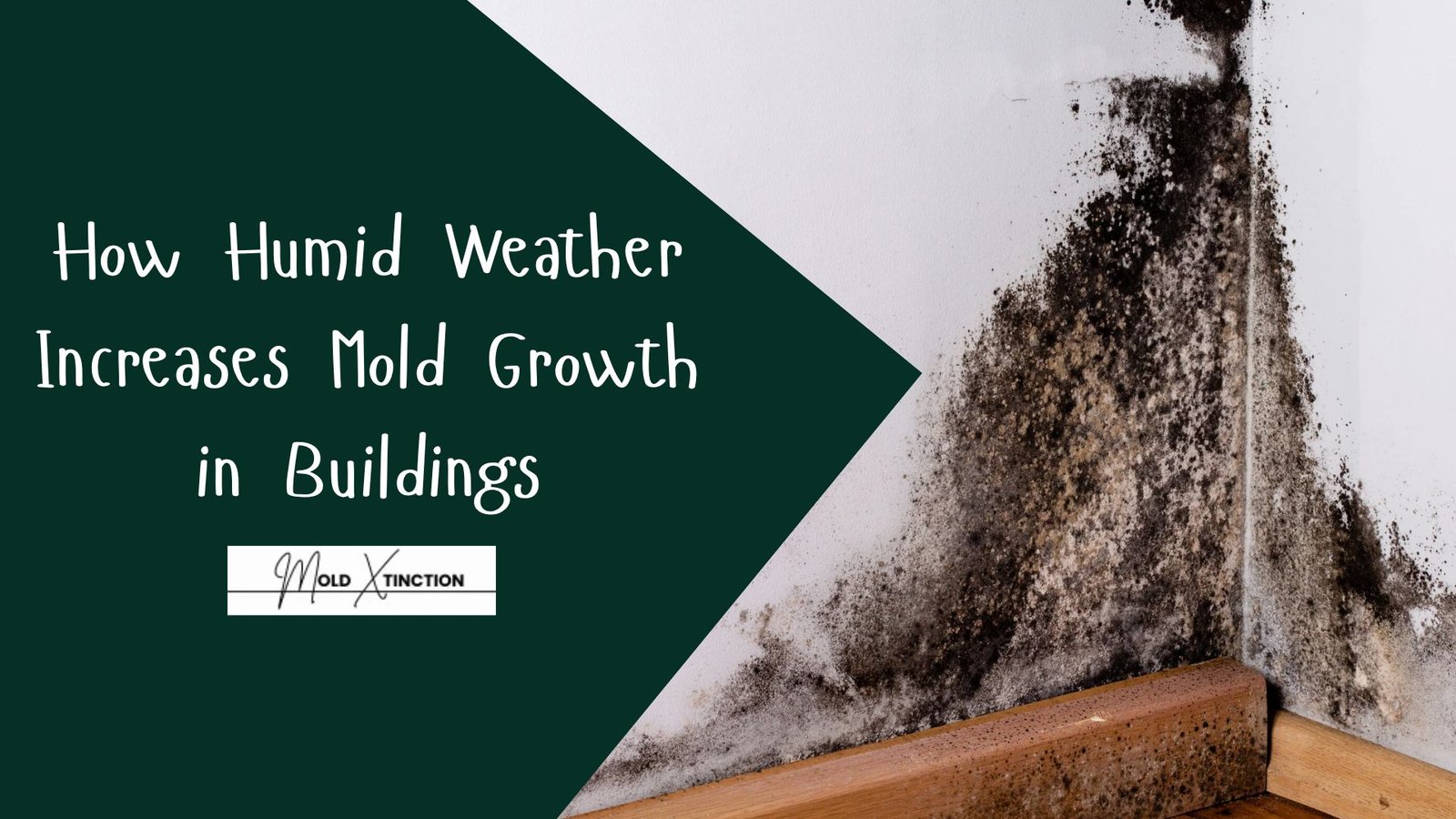I have also been wondering how humid weather increases mold growth in buildings, till I found out why, and you will get to see as you read on.
We all know humidity, those of us who live in the rainy season or who have rivers, lakes or the sea near our homes. Moisture is abundant in the air during humid weather. It’s sticky, heavy, warm.
We don’t want little moisture but when moisture is excess in our building or residence then it might cause big problems. Mold is one of the biggest problems that can be caused by high humidity indoors.
Mold is a fungus that grows fast under warm and wet conditions. It is transmittable and could be manifested on the walls, ceilings, floor coverings, wooden tables and clothes. Mold thrives on moisture as it would be a right place to grow and multiply rapidly.
The problem can also escalate where there is little air circulation and these places are small rooms and areas where ventilation is blocked.
If left untreated for a short period of time, mold can cause damage to property etc. even to our health, maybe to the asthmatic and allergy sensitive.
In this article, we will look into how humid weather contributes to mold growth, their favorite places, their unfriendliness and the best ways to prevent their recurrence.
What's In This Article
ToggleWhat Is Humidity?
Humidity is the amount of water in the air (in the form of tiny water drops). It’s invisible but you can certainly feel it. Moisture is a big contributor to our discomfort both at home and outdoors.
- The air is sticky, warm and heavy, that’s an indication that the air is very humid.
- Low humidity is felt when your skin is dry, when your lips crack or when your throat gets dry.
You need to have the right balance. Normal indoor humidity should be between 30 to 50%. That’s the comfort zone and your health and properties are reasonably secured.
But things start to go wrong when the relative humidity is above 60% indoors. Mold growth is one of the common problems. Mold is a fungus that grows very fast in damp areas. It can grow on:
- Walls/ceilings
- Shoes and clothes
- Wood furniture and carpets
The damage to your property is not the only disadvantage, high humidity can also cause breathing difficulties and for asthmatics, medical complications. So regulating the moisture at home is also important.
How Humid Weather Increases Mold Growth in Buildings

Air also becomes humid when it is wet. Water may stand on chill places such as walls or window or even your floor. These are moisture ridden spots and an ideal location where mould will grow.
1. Moisture Build-up = Warm + Humid Air
Humid air condenses on a cold surface to form water droplets when heated. This we call condensation. Such clouding can be seen as water droplets on a cold concrete surface or metal pipe because of saturated air. These damp places are mould’s favourite. Any space that has condensation can soon become a mould breeding ground since mould needs moisture to grow and live.
2. No Airflow
Lack of ventilation is common in most buildings especially when windows are off. This is a big problem in areas like kitchen, basement and bathroom. These areas are damp for hours. When air is not able to flow or dry up, the room will be humid. Since the dampness is not drying up fast, mould is growing very fast in such areas.
3. Water is absorbed by Moist Materials
Materials like cloth, paper, drywall and wood can absorb water in the air. These items will take more than 24/48hrs to dry up before mould can grow on or inside them. This is why mould appears on walls, carpet, curtains, ceilings and furniture when the house is humid. These elements absorb water fast.
4. No Sunlight = Mould Growth
Dark and wet places are mould’s favourite. There are many rooms that do not receive sunlight during rainy days. Mould grows faster when there is no light and air circulation. Mould is kept away by drying spaces in sunlight.
Signs of Mould Growth in Humid Weather
Here are some of the signs that may indicate mould growth in your home:
- Smells bad, musty smell (indeed like damp socks or wood),
- Dark spots, black, green or white, appearing on walls and ceilings or even on your clothes.
- Chipped paint or wall paper,
- Damp spots that did not dry,
- Or asthmatic problems that worsen at home.
Act fast when you experience one of these.
Common Places Mould Hides During Humid Seasons
Mould doesn’t just grow in plain sight. It also hides in quiet, wet corners like:
- Behind bathroom tiles
- Inside walls and ceilings
- Under carpets and floorboards
- Inside air conditioning systems* On window sills
- Behind furniture near damp walls
- In the attic or basement
Even clean homes can get mould during humid weather. The key is to dry things.
Health Problems Caused by Mould
Mould is not just ugly, it’s also harmful to people. Especially infants, the elderly or people with asthma or suppressed immune system.
Some of the health problems that mould can bring about are:
- Sneezing occasionally
- Coughing constantly
- Itchy eyes and skin
- Headaches
- Breathing problems
- Chest tightness or wheezing
If someone in your home is always sick but feels better outside, mould may be the cause.
How to Prevent Molds During Humid Weather
Good news, you can minimize molds through moisture control. Here are the simple steps:
1. Use Dehumidifier
A dehumidifier removes the extra water in air. Put one in areas that are usually wet such as bathrooms or basements. The humidity should be maintained at 30-50%.
2. Open Windows for Airflow
Open your windows to get fresh air in when the outside air is dry as this will speed up drying of wet surfaces.
3. Fix Leaks ASAP
Make sure there’s no leakage in your pipes, roof or tap. Leaks as small as drips can lead to molds if not taken care of.
4. Use Exhaust Fans
Kitchen and bathroom fans should always be turned on. This will get rid of steam and maintain dry air.
5. Wipe Wet Surfaces
Any wet surfaces should be immediately cleaned with a dry cloth. Don’t allow it to overstay. Once you find wet surfaces, please clean them up. You know mold loves wet areas to thrive in.
6. Don’t Hang Clothes in the House
With wet clothes, the moisture is spread in the air. Better with no option available to dry them indoors, ensure that a fan or dehumidifier is operated.
7. Clean ACs
ACs can trap moisture and fungus inside. Replace or clean filters frequently during humid season.
Why DIY Mold Cleaning Isn’t Enough
Many people try to clean mold with vinegar or bleach. But there are times when the mold penetrates deeper into the walls or materials.
The cleaning done on the surface is external. In this case, mold will come back again and again.
If you have a big mold issue or you’re not sure how serious the problem is then don’t risk it.
Call a Professional Mold Remediation Service
If mold keeps coming back or you notice a musty smell in your building, don’t wait.
Professional mold removal experts can:
- Find hidden mold using tools and tests
- Remove all mold safely
- Dry the space completely
- Treat the air and surfaces to prevent future growth
It’s not safe to deal with mold yourself especially during rainy seasons. A professional company can make sure your home is clean, dry and mold-free.
Helpful Guide: How Mold Lowers the Value of Residential Properties
Conclusion
Rainy weather can sneak up on your house and turn it into a mold factory. Mold will appear in areas with low air circulation where moisture is present, from a musty smell to a humid wall. Although minor issues may seem no big deal, mold is not something you should ignore and let it grow and affect your health and home. If you see mold, don’t wait. To get rid of it and prevent it from coming back, call a professional mold removal service to remove it safely. There’s no better way to protect your territory and your loved ones.
FAQs
1. How does the presence of humidity enhance the growth of mold?
Mold can be cultivated with the help of water. The air is humid and contains water. Such excess water may go on the walls, ceiling and furniture where the mold will have a favorable environment to develop.
2. What are the areas of molds in buildings during wet season?
Molds tend to occur in places that are wet including bathrooms and basements. These locations are not very well exposed to fresh air and therefore, water remains there and molds can grow with ease.
3. What are the risks of molds at home?
Mold produces rashes on the skins, sneezing, and coughing. Such a person may have an impediment to breathing by mold whether he or she is asthmatic or allergic. It can also damage the wood, walls and paints in the house.
4. How to prevent mold in humid weather?
Preventing mold can be done with fans and opening of windows for air circulation and use of dehumidifiers. Fix leaks immediately and wipe away any condensate or water you see. To prevent mold from appearing, you can keep rooms dry.
To prevent molds in your home during wet days, the trick is to control moisture.


